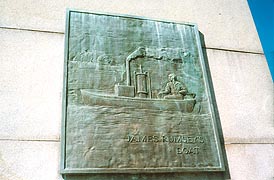1633. William Claiborne opened trading post on Palmers Island (now Watson's Island) near mouth of Susquehanna River.
1660. Bohemia Manor established by Augustine Herrman (c. 1621-1686).
1663. Augustine Herrman, first naturalized citizen of Maryland.
1670. Authoritative map of Maryland (engraved, London, 1673) completed by Augustine Herrman.
1674. Cecil County erected from Baltimore and Kent counties by proclamation of Governor, named for Cecilius Calvert, 2nd Lord Baltimore, and founder of Maryland colony.
1683. Labadist community settled at Bohemia Manor.
1692. First Courthouse built by Casparus Herrman (1656-1697) at Jamestown (later Oldtown).
1695. Lower Susquehanna Ferry established at Perryville to transport passengers to Havre de Grace.
![[photo, Deck cannon made by Principio Iron Furnace (Cecil County), Havre de Grace Decoy Museum, 215 Giles St., Havre de Grace, Maryland]](/msa/mdmanual/36loc/ce/chron/images/1198-1-07194b.jpg) 1717. Courthouse constructed at Courthouse Point.
1717. Courthouse constructed at Courthouse Point.
1719. Principio Iron Works, first blast furnace in Maryland, founded near Perryville, financed by English capital.
1733, Sept. 18. George Read (1733-1798), Delaware signer of Declaration of Independence, born at Charlestown.
Deck cannon made by Principio Iron Furnace (Cecil County), Havre de Grace Decoy Museum, 215 Giles St., Havre de Grace, Maryland, June 2015. Photo by Sarah A. Hanks.
 1742. Charlestown incorporated.
1742. Charlestown incorporated.
1743. James Rumsey (1743-1792), inventor of steamboat, born near Warwick.
1744. West Nottingham Academy founded by Samuel Finley near Colora.
"James Rumsey's Boat" memorial, commemorating Dec. 3, 1787, demonstration of first steamboat on Potomac River at Shepherdstown, Virginia, by James Rumsey (born in Cecil County, Maryland), October 2007. Photo by Diane F. Evartt.
1765, May. Surveyors Charles Mason and Jeremiah Dixon reached Susquehanna River.
1774, Jan. 31. Thomas W. Veazey (1774-1842), Governor of Maryland, born near Earleville.
1776, Aug. Maryland Flying Camp moved through Head of Elk en route to New York.
1776, Sept. 16. Eastern Shore Battalion of Flying Camp fought under Colonel William Richardson at Battle of Harlem Heights.
1777, Aug. 27. British fleet and troops under Gen. William Howe (1729-1814) landed at Elk River, encamped at Elkton, on route to Philadelphia.
1778, March 19. Elkton-born Capt. Michael Rudolph led capture and burning of British galley HM Alligator that had blocked Charleston harbor, South Carolina.
1781, April 12. Army of Marie-Joseph Paul Yves Roch Gilbert du Motier, Marquis de La Fayette, encamped near Calvert.
1781, Sept. 6-7. Combined forces of Gen. George Washington and Jean Baptiste Donatien de Vimeur, Comte de Rochambeau, encamped at Elkton en route to Yorktown.
1781, Sept. 10. Rochambeau's Artillery moved south through Conowingo en route to Yorktown.
1787. Head of Elk is incorporated as Elkton.
1792. Courthouse at Elkton completed.
1813. British fleet sailed to Elkton; fighting at Fort Defiance.
1813, April 29. Frenchtown burned by British troops under Rear Admiral Sir George Cockburn.
1813, May 3. Havre de Grace and Principio Furnace burned by British troops.
1824. Port Deposit incorporated.
1824-1829. Chesapeake and Delaware Canal constructed through Cecil County to link Chesapeake Bay with Delaware River.
1831. New Castle and Frenchtown Railroad linked Cecil County to Delaware.
1832, March 5. Baltimore and Port Deposite Rail Road incorporated.
1838, April 4. James Black Groome (1838-1893), Governor of Maryland, born at Elkton.
1849. Chesapeake City incorporated.
1850. North East incorporated.
1860. Rising Sun incorporated.
1860, May 17. Austin Lane Crothers (1860-1912), Governor of Maryland, born near Conowingo.
1861, April-May. Union troops stationed at Perryville, Havre de Grace, and Elkton following Pratt Street Riot in Baltimore.
1861, May. Union troops stationed at Chesapeake City, North East, and Charlestown following Pratt Street Riot in Baltimore.
1861, Sept. 26. Fred Pearce lynched at Cecilton.
1864. Cecilton incorporated.
1872, July 27. John Jones lynched near Pivot Bridge village.
1882. Perryville incorporated.
1894. Tome School for Boys opened at Port Deposit.
1928. Conowingo Hydroelectric Generating Station (Conowingo Dam) began operation on the lower Susquehanna River, spanning the border between Cecil and Harford counties.
![[photo, Cecil County Courthouse, 129 East Main St., Elkton, Maryland]](/msa/mdmanual/36loc/ce/jud/images/1198-1-08681c.jpg) 1940, July 26. Second Courthouse at Elkton dedicated.
1940, July 26. Second Courthouse at Elkton dedicated.
1940, Dec. Susquehanna River Toll Bridge (now Thomas J. Hatem Memorial Bridge) opened, linking Cecil and Harford counties.
1941. Route 40 ran through Cecil County, linking Baltimore with Delaware.
1941. Tome School for Boys closed Port Deposit campus.
Courthouse, 129 East Main St., Elkton, Maryland, May 2018. Photo by Diane F. Evartt.
1943, May 4. Explosions at Elkton ammunition factory, Triumph Explosives, killed fifteen workers and injured scores more.
1954, July 31. First Cecil County Fair held at Fair Hill.
1964, June. County public schools desegregated.
1968. Cecil Community College opened.
1969. Wilmington Area Planning Council created for region including Cecil County, Maryland, and New Castle County, Delaware.
1971. Tome School moved to new campus in North East.
1976, June 30. U.S. Naval Training Center, Bainbridge closed following deactivation on March 31, 1976.
1986. Susquehanna River Toll Bridge renamed Thomas J. Hatem Memorial Bridge.
2002, June 18. Aberdeen IronBirds affiliated with Baltimore Orioles and began playing at Ripken Stadium.
2003. Upper Shore Regional Council created.
2004, March 2. Electronic voting system used during primary elections at polling places and for absentee ballots in all counties and Baltimore City.
2007. Cecil Community College renamed Cecil College.
2010, Sept. 27. Hollywood Casino, the first gambling facility in Maryland with video lottery terminals [slot machines], opened at Perryville.
2010, Nov. 2. Cecil County voters adopted charter form of government with a County Executive and County Council.
2012, Dec. 3. Cecil County's first County Executive and County Council sworn in.
2012, Dec. 3 - 2016, Dec. 5. Tari Moore (Republican), County Executive.
2016, Dec. 5 - 2020, Dec. 7. Alan J. McCarthy (Republican), County Executive.
2020, Dec. 7 -. Danielle M. Hornberger (Republican), County Executive.
© Copyright Maryland State Archives